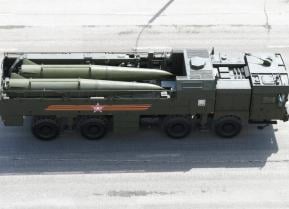American Military Support for Ukraine Must Continue
The stakes for the United States are simply too high for America to turn a blind eye to a war that could spread well beyond the borders of Ukraine and ultimately threaten both American world leadership and its national security.
Although both the House and Senate leaderships have agreed to a top-line budget of $1.59 trillion (with an additional “side deal” of $79 billion) for fiscal year 2024, there remains the requirement to pass the remaining eight appropriations bills to avoid a partial government shutdown. With time running out before a shutdown, Congress will likely have to pass another Continuing Resolution that would last long enough for the appropriations bills to pass. Critically, however, even if all the appropriations bills were signed into law before January 19, when the first tranche of bills must pass, Congress would not yet have passed legislation to provide additional funding for Ukraine.
The Biden administration’s October supplemental appropriations request for $106 billion, upon which Congress has yet to act, consists of funding to provide additional military and economic support to Ukraine, assistance to Israel and Taiwan, and resources for border protection programs. Funding for Ukraine, which totals $61.4 billion, is by far the largest item in the supplemental request. The defense-related aid package, the most critical element of the Ukraine-related request, amounts to over $44.4 billion for items in the DoD operations and maintenance accounts. These provide for, among other things, personnel support, intelligence analysis, flying hours, replacement of defense materiel sent to Ukraine, reimbursement for services provided to Ukraine, and defense production capacity expansion. The administration is requesting an additional $6 billion in the DoD procurement account, consisting of funds to increase the production of missile systems and critical munitions, for ship depot maintenance, for cybersecurity, and for some classified programs.
Late in December, with Congress failing to act on his supplemental request, President Joe Biden announced yet another drawdown of military equipment for Ukraine. It was the fifty-fourth such drawdown since 2021. The DoD reported that the latest drawdown consisted of air defense capabilities, artillery, antitank weapons, and other equipment totaling $250 million.
While certainly to be welcomed, the sum involved is but a tiny fraction of Ukraine’s urgent requirements and, indeed, what the supplemental calls for. Moreover, reportedly, the drawdown is likely to be the last of its kind, so that absent the passage of the supplemental, even the trickle of military aid to Ukraine will come to a complete halt.
The supplemental’s fate depends not so much on congressional attitudes toward supporting Ukraine, though these have slowly cooled since the Russians invaded the country in February 2022, but rather on whether Congress can reach an agreement on funding and policies for border control. Even if such an agreement could be reached and the supplemental approved, it is not at all certain that the Administration could push through a follow-on supplemental later this year.
Ukraine is no longer the center of media and public attention. Moreover, to the extent foreign policy will be a major issue in the presidential election campaign, it is more likely to focus on the Middle East—especially with Israel still at war—and on China, whose aggression in the South China Sea is unlikely to diminish, rather than on the war in Europe. Moreover, Ukraine’s failure to achieve anything like a decisive result in its much-ballyhooed spring counteroffensive has also dampened congressional enthusiasm, especially among an increasing number of Republicans who question whether it is worth continuing to spend large sums to support Kyiv.
Clearly, should no additional supplemental funding be forthcoming, Ukraine will find itself entirely dependent on European and other allies for equipment, logistics support, and training. Since Washington has provided roughly half of all military funding to support Ukraine, the absence of American support would jeopardize Ukraine’s chances of retaining the territory it currently controls, much less adding to it.
Indeed, in recent days, Russian forces have slowly seized some additional Ukrainian territory, west and south of Marinka near Donetsk City as well as southwest of the city near Novomikhailivka. The Russian objective remains to take control of all of Donetsk and Luhansk to strengthen its claim to the two rebellious provinces. Though Russia has lost most of the forces that initially attacked Ukraine, it has replenished them with a mélange of older and younger draftees. Ultimately, Russian forces vastly outnumber those of Ukraine, and Putin has shown no compunction about employing a meatgrinder strategy if that is what it takes both to block Ukrainian advances and to inch Russian forces forward. While Ukrainian forces have generally kept Russian troops at bay until now, it will be much harder for them to do so if American assistance dries up.
Putin is determined to stay the course and prosecute his war, in President Biden’s words, “for as long as it takes.” Staying the course means, at a minimum, pursuing Russian operations until after the American presidential election, from which Putin surely hopes that Donald Trump, who has no interest in supporting Ukraine, will emerge victorious. Congressional reluctance to fund additional military support for Ukraine would only further encourage Putin to resist any overtures for a negotiated solution to the war.
In the absence of American support for Ukraine, the odds that Russia will achieve its objectives will rise dramatically. It could either ingest all of Ukraine in one fell swoop or bite off a portion of the country, leaving it as little more than a rump state, which Moscow could ultimately swallow much as Hitler swallowed post-Sudetenland Czechoslovakia. Moreover, like Hitler, Putin is unlikely to remain satisfied with absorbing Ukraine into what he considers to be historical Russia. Moldova would probably be next. And then, if Trump makes good on his promise to re-evaluate American participation in NATO should he return to the White House, one or more of the Baltic states would be sure to follow.
There is no predicting the outcome of the November elections. If a month is a long time in politics, ten months is even more so. Still, the specter of an indifferent America led by Donald Trump should worry all legislators who care about the future of a free Europe and what the loss of that freedom would mean for the United States. For that reason, Congress should fund the supplemental as soon as President Biden signs the various appropriations bills that will come before him in the next weeks. And Biden, in turn, should request yet another follow-on supplemental.
The stakes for the United States are simply too high for America to turn a blind eye to a war that could spread well beyond the borders of Ukraine and ultimately threaten both American world leadership and its national security.
About the Author: Dov S. Zakheim
Dov S. Zakheim is Vice Chairman of the Foreign Policy Research Institute, a Senior Advisor at the Center for Strategic and International Studies, and a member of The National Interest Advisory Board. He is a former Under Secretary of Defense and Deputy Under Secretary of Defense.
Image: Shutterstock.


